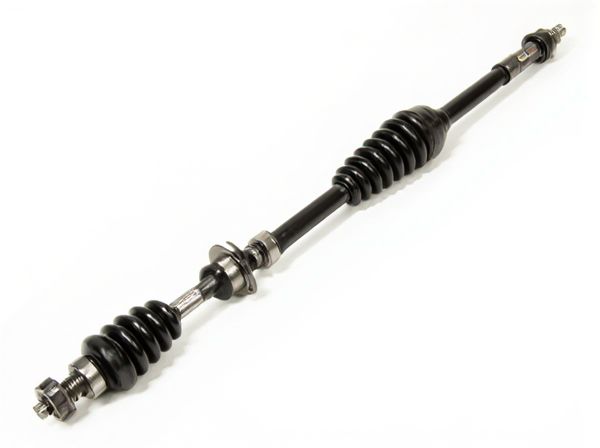
Photo illustration: One-Piece Driveshaft vs Two-Piece Driveshaft
A one-piece driveshaft offers greater strength and less maintenance due to its simpler design, making it ideal for high-performance or heavy-duty vehicles. Two-piece driveshafts provide enhanced flexibility and better vibration control, which is beneficial for longer wheelbases and off-road applications. Choosing the right driveshaft depends on your vehicle's specific needs for durability and smooth power transmission.
Table of Comparison
| Feature | One-Piece Driveshaft | Two-Piece Driveshaft |
|---|---|---|
| Design | Single, continuous shaft | Two connected shafts with center support bearing |
| Length | Best for shorter wheelbases (under 70 inches) | Designed for longer wheelbases (over 70 inches) |
| Weight | Lighter overall | Heavier due to extra components |
| Vibration | Higher risk of vibration in long driveshafts | Reduced vibration with support bearing |
| Maintenance | Less maintenance, fewer parts to service | Requires bearing and joint inspections |
| Cost | Generally lower cost | Higher cost due to complexity |
| Durability | Durable for short to medium length applications | Better durability for heavy-duty, long driveshafts |
Introduction to Driveshafts: One-Piece vs Two-Piece
One-piece driveshafts consist of a single, solid shaft designed for simpler, lighter vehicles, offering direct power transfer but limited flexibility in length and vibration control. Two-piece driveshafts incorporate an additional universal joint and center support bearing, allowing for longer driveshafts and improved vibration reduction, ideal for trucks and vehicles with extended wheelbases. Understanding the structural differences helps in selecting the appropriate driveshaft based on vehicle size, performance requirements, and driveline configuration.
Core Design Differences
One-piece driveshafts consist of a single, solid shaft that transmits torque directly from the transmission to the differential, offering simplicity and reduced weight. Two-piece driveshafts incorporate a center support bearing and are segmented into two sections, allowing for longer vehicle applications and improved vibration dampening. The core design difference lies in the single continuous structure of one-piece driveshafts versus the segmented construction with additional support in two-piece driveshafts, impacting durability and flexibility in various automotive setups.
Material Composition and Construction
One-piece driveshafts are typically constructed from a single solid steel or aluminum tube, providing superior torsional rigidity and reduced weight, which enhances overall drivetrain efficiency. Two-piece driveshafts consist of two separate shafts connected by a center support bearing, often utilizing steel for increased durability and flexibility in longer vehicle applications. Material composition directly influences performance characteristics, with one-piece designs favoring lightweight alloys for high-performance vehicles and two-piece designs employing robust steel for heavy-duty or extended driveshaft lengths.
Performance and Power Transmission
One-piece driveshafts offer superior power transmission efficiency due to their continuous construction, minimizing energy loss and vibration, which enhances vehicle performance. Two-piece driveshafts, often used in longer or heavy-duty applications, provide improved flexibility and durability by accommodating slight misalignments and reducing stress on drivetrain components. However, the additional joints in two-piece driveshafts can introduce minor power loss and vibration compared to the seamless design of one-piece driveshafts.
Pros and Cons of One-Piece Driveshafts
One-piece driveshafts offer superior strength and durability due to fewer connection points, reducing the likelihood of failure under high torque applications. Their simpler design minimizes maintenance and vibration issues, enhancing overall drivetrain efficiency. However, they are less flexible in accommodating vehicle length variations and can be more susceptible to damage from road impacts compared to two-piece driveshafts.
Pros and Cons of Two-Piece Driveshafts
Two-piece driveshafts offer improved flexibility and reduced vibrations by incorporating a center support bearing, which enhances driveline stability in longer wheelbase vehicles. They provide easier installation and maintenance since individual sections can be serviced without removing the entire driveshaft assembly. However, the additional center bearing introduces potential points of failure and requires periodic inspection, while also adding slight weight and complexity compared to one-piece driveshafts.
Application: When to Use One-Piece vs Two-Piece
One-piece driveshafts are best suited for short wheelbase vehicles and applications with minimal drivetrain angles, providing simplicity and reduced weight for efficient power transfer. Two-piece driveshafts are ideal for long wheelbase trucks and off-road vehicles, accommodating greater distances and allowing flexibility with center support bearings, which reduces vibration and improves durability. Choosing between one-piece and two-piece driveshafts depends on vehicle length, drivetrain alignment, and torque demands for optimal performance and reliability.
Installation and Maintenance Considerations
One-piece driveshafts offer simpler installation due to fewer components, reducing alignment complexity and potential balancing issues; however, they can be more challenging to fit in vehicles with longer wheelbases or tighter spaces. Two-piece driveshafts provide easier installation in larger vehicles by breaking the shaft into manageable sections connected by a center bearing, which simplifies alignment but requires careful maintenance of the bearing and additional U-joints. Maintenance-wise, one-piece driveshafts have fewer wear points but can be more costly to replace entirely if damaged, whereas two-piece driveshafts may require more frequent inspections of multiple joints and bearings but allow for partial shaft replacement, potentially lowering repair costs.
Impact on Vehicle Handling and Comfort
One-piece driveshafts provide a more direct power transfer, resulting in improved responsiveness and vehicle handling, especially in performance-oriented applications. Two-piece driveshafts, equipped with a center support bearing, offer enhanced vibration dampening and reduced driveline lash, which significantly improves ride comfort on long-distance or rough road conditions. The choice between one-piece and two-piece driveshafts affects torque delivery efficiency, NVH (noise, vibration, harshness) characteristics, and overall driving dynamics.
Choosing the Right Driveshaft for Your Vehicle
Selecting the right driveshaft for your vehicle depends on factors such as vehicle size, power output, and intended use. One-piece driveshafts offer increased strength and reduced maintenance for lighter vehicles and straightforward drivetrains, while two-piece driveshafts provide enhanced flexibility and vibration reduction for longer wheelbases and heavy-duty applications. Proper driveshaft alignment and material choice, such as aluminum or steel, also influence performance and durability.
 caratoz.com
caratoz.com